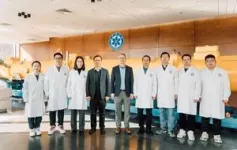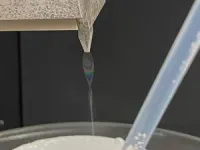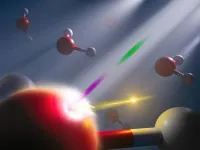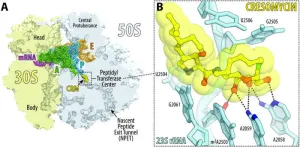(Press-News.org) Scientists have observed so-called 'roaming' chemical reactions, those that at certain points move away from the lowest minimum energy 'path of least resistance', in highly excited energy states for the first time.
Chemical reactions are supposed to occur along their minimum energy paths. In recent years, so-called roaming reactions that stray far from this path have begun to be observed, but only for chemical species in their ground state or, at most, their first excited state. However, researchers have now observed a roaming reaction even in highly excited energy states.
The researchers from the Dalian Institute of Chemical Physics (DICP) of the Chinese Academy of Sciences (CAS) described their findings in a paper appearing in Science on Feb. 16.
Until recently, chemists had assumed that chemical reactions occur along what they call minimum energy paths—the reaction pathway that uses the lowest amount of energy between the starting stable configuration of a molecule and its final stable state. At a certain point in any chemical reaction, there lies a “transition state", at which the potential energy has a maximum value. This can be thought of as akin to a ball rolling up a hill and down again. But that transition state at the "top of the hill" still lies along the minimum energy path. Reactions aren't supposed to stray away from this path of least resistance.
But in 2004, researchers exploring the breakdown of formaldehyde when being bombarded by photons (a chemical reaction called "photodissociation") were shocked to discover that there are chemical reactions that can, in fact, stray well away from the minimum energy path.
This straying, or more properly "roaming," happens when the expected cleavage of a chemical bond instead becomes "frustrated": a component of a molecule begins to escape its parent molecule, but finds it does not have sufficient energy to do so. So instead, the component just orbits the remaining molecular fragment in a non-minimum-energy state. It continues this orbit until it bumps into a reactive site (the physical location on a molecule where the reaction takes place and a new chemical bond is formed) of another molecule, returning to the minimum energy path.
Since then, these "roaming reactions" have been found to not just be occasional occurrences, but common ones.
"It turned out that roaming is a general aspect of chemical reactivity that had never been noticed before," said FU Bina, one of the corresponding authors of the paper from DICP.
Further investigations have observed roaming reactions in both ground states—a molecule's lowest possible energy, and in their first excited states. When absorbing energy, an electron in a molecule jumps up to higher energy levels, called excited states. But roaming had only been observed in the first such excited states, not in any subsequent, higher excited states. Nor has roaming been observed to lead to the generation of electronically excited products of the chemical reaction.
The authors of the paper however reported they had observed roaming in a highly excited state for the first time, in this case during the photodissociation of sulfur dioxide (SO2) molecules into sulfur and oxygen (a molecule of SO2 breaks down into an atom of sulfur, S, and one molecule of oxygen, O2, when bombarded by light).
Their results revealed two different possible pathways for dissociation. One proceeds along the expected minimum energy path to produce a "vibrationally colder" O2 molecule, and the other yields a "vibrationally hotter" O2 molecule in its electronically excited state.
"The latter reaction does this via a roaming pathway involving a sort of 'blob' of a single oxygen atom, what we call an 'intramolecular O- abstraction', during a motion in which the molecule reorients itself," said YUAN Kaijun, another corresponding author of the paper from DICP.
Any time there is an increased probability of encountering "frustrated bond cleavage," there is an increased likelihood of roaming reactions in highly excited states and production of electronically excited products. Such roaming dynamics may turn out to be the rule, the researchers believe, rather than the exception for molecular photodissociation through highly excited states.
The researchers were interested in SO2 in particular, given its importance in the Earth's atmosphere. Changes in the abundance of SO2 impact the radiation balance of the planet and thus the climate, and SO2 from volcanic eruptions is one of the two most important sources of aerosols in the stratosphere, and electronically excited products themselves react very differently in the atmosphere, in space, and in combustion. Finally, photodissociation of SO2 could be of great importance for understanding the sources of molecular oxygen (O2) in the Earth's primitive atmosphere prior to the emergence of life.
As a result of their findings, the researchers argue that the roaming mechanism of molecular oxygen production should now be incorporated into photochemical modelling of the atmospheres of planets with rich volcanic outgassing of SO2.
END
Researchers observe highly excited ‘roaming’ energy pathway in chemical reactions
2024-02-15
ELSE PRESS RELEASES FROM THIS DATE:
MSU, Carnegie Science introduce a big new idea with the help of tiny plankton
2024-02-15
Researchers at Michigan State University and the Carnegie Institution for Science have developed a model that connects microscopic biology to macroscopic ecology, which could deepen our understanding of nature’s laws and create new opportunities in ecosystem management.
Reporting in the journal Science on Feb. 16, the team showed how microscopic relationships in plankton — such as between an organism’s size and nutrient consumption — scales up to predictably affect food webs.
“Using data that other researchers have measured at the microscale about these organisms, our model can predict what’s happening at the scale of whole ecosystems,” said Jonas ...
First-ever atomic freeze-frame of liquid water
2024-02-15
RICHLAND, Wash.—In an experiment akin to stop-motion photography, scientists have isolated the energetic movement of an electron while “freezing” the motion of the much larger atom it orbits in a sample of liquid water.
The findings, reported today in the journal Science, provide a new window into the electronic structure of molecules in the liquid phase on a timescale previously unattainable with X-rays. The new technique reveals the immediate electronic response when a target is hit with an X-ray, an important step in understanding the effects of radiation exposure on objects and people.
“The chemical reactions induced by radiation ...
Superbug killer: New synthetic molecule highly effective against drug-resistant bacteria
2024-02-15
A new antibiotic created by Harvard researchers overcomes antimicrobial resistance mechanisms that have rendered many modern drugs ineffective and are driving a global public health crisis.
A team led by Andrew Myers, Amory Houghton Professor of Chemistry and Chemical Biology, reports in Science that their synthetic compound, cresomycin, kills many strains of drug-resistant bacteria, including Staphylococcus aureus and Pseudomonas aeruginosa.
“While we don’t yet know whether cresomycin and drugs like it are safe ...
With just a little electricity, MIT researchers boost common catalytic reactions
2024-02-15
CAMBRIDGE, MA — A simple technique that uses small amounts of energy could boost the efficiency of some key chemical processing reactions, by up to a factor of 100,000, MIT researchers report. These reactions are at the heart of petrochemical processing, pharmaceutical manufacturing, and many other industrial chemical processes.
The surprising findings are reported today in the journal Science, in a paper by MIT graduate student Karl Westendorff, professors Yogesh Surendranath and Yuriy Roman-Leshkov, and two others.
“The results are really striking,” says Surendranath, a professor of chemistry ...
Keeping telomerase in check
2024-02-15
The natural ends of chromosomes appear alarmingly like broken DNA, much as a snapped spaghetti strand is difficult to distinguish from its intact counterparts. Yet every cell in our bodies must have a way of differentiating between the two because the best way to protect the healthy end of a chromosome also happens to be the worst way to repair damaged DNA.
Consider the enzyme telomerase, which is responsible for maintaining protective telomeres at the natural ends of chromosomes. Were telomerase to seal off a broken strand of DNA with a telomere, it would prevent further repair of that break and delete essential genes. Now, a new study in Science describes how cells avoid ...
Competition for food drives the planet’s remaining mass migration of herbivores
2024-02-15
Upending the prevailing theory of how and why multi-species mass-migration patterns occur in Serengeti National Park, researchers from Wake Forest University have confirmed that the millions-strong wildebeest population pushes zebra herds along in competition for the most nutrient-dense grasses.
The study resulting from this research, “Interplay of competition and facilitation in grazing succession by migrant Serengeti herbivores,” appears today in the peer-reviewed journal Science.
For decades, biologists have believed the major grazing ...
UT Dallas Wind Energy Center to expand with new headquarters, resources
2024-02-15
The University of Texas at Dallas’ wind energy research programs have expanded rapidly in recent years, with labs, offices and facilities spread out on campus. In 2020 UT Dallas formed the Wind Energy Center, called UTD Wind, to bring its wind energy programs under one virtual umbrella.
Now, a new initiative will give UTD Wind a physical headquarters for the first time with additional labs, meeting areas and office space. The project also includes additional equipment for wind energy research and education.
UT Dallas has received $1.6 million through the federal Consolidated Appropriations Act to support the expansion, which will bring most of the center’s ...
More Aston University scholarships to encourage graduates from under-represented groups to work in artificial intelligence
2024-02-15
• Eleven scholarships worth £10k each for MSc Applied AI
• They are funded by the Office for Students (OfS)
• Aimed at graduates without a science, tech, engineering or maths degree.
Aston University is offering more opportunities to graduates who want a career in artificial intelligence (AI) but don’t have a science, technology, engineering or maths degree.
The scholarships are offered due to increased funding from the Office for Students (OfS). Each award is worth £10,000 and will be awarded to students enrolling ...
How is deforested land in Africa used?
2024-02-15
Africa's forested areas – an estimated 14 % of the global forest area – are continuing to decline at an increasing rate – mostly because of human activities to convert forest land for economic purposes. As natural forests are important CO2 and biodiversity reservoirs, this development has a significant impact on climate change and effects the integrity of nature. To intervene in a targeted manner in the interests of climate protection and biodiversity, there has been a lack of sufficiently good data and detailed knowledge ...
Studies with more diverse teams of authors get more citations
2024-02-15
Diverse research is more impactful in the business management field, with female influence growing stronger in the past decade, finds a new study from the University of Surrey.
The study analysed all articles published in the last 10 years (January 2012 to December 2022) in the influential Journal of Management Studies.
The empirical analysis examined three key aspects of teams’ diversity:
Internationality (how international is mix of authors),
Interdisciplinarity (how many different fields of study they come from),
Gender ...








